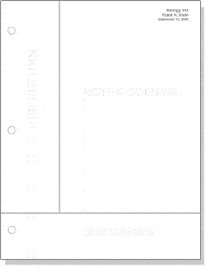Cornell Note Taking Method Custom Pdf Generator Downloads
This article explains the Outline Method of Note Taking in a practical way. After reading, you’ll understand how you can effectively take notes and get to work with this powerful note taking tool. What is the Outline Method of Note Taking?The Outline Method of Note Taking is a frequently used tool for effective note taking.
Students use the method, sometimes unconsciously, when taking notes during a lecture, but professionals also use the method during meetings or training seminars. Despite the fact that this method does not get much attention in schools and universities, it is a valuable tool that benefits many people. As you might expect from the name, the Outline Method of Note Taking is about making an outline of the attended lecture or meeting. How does it work?Organisation is what goes wrong most often when taking notes.
Cornell Note Taking Method Definition

Random elements are written down without structure and the notes are often forgotten or no longer understood because the context is missing. The Outline Method of Note Taking provides more structure, making it possible to still be able to correctly interpret the main issues at a later date.People often use bullet points, numbers or arrows to indicate a new subject or when a new thought is introduced. Every new subject of the lecture or meeting is set as far to left of the page as possible. All additional matters that belong to this subject are then tiered to the right beneath this subject. A new subject is written straight beneath the first subject. An example is given below.Pros and cons of the Outline MethodThe use of the outline method has several advantages. The method ensures that – in addition to the content being written down in a structured way – the relationship between different subjects is also clearly visible in the notes.Another benefit of the outline method is the focus that remains to keep following the lecture or meeting.
The method does not require fast writing skills, because only the main and side issues are noted down. This ensures that all main issues can be noted down and no valuable information is lost.By using the outline method, there is also less time needed to edit the notes later, as all important information has already been written down. Students can change the main issues into questions in order to study the material more in-depth.The use of the outline method is less suitable for lectures with a mathematical content. In this case, the correct use of formulas is more important than the relationship between main issues. The is more suitable for that. Now it is your turnWhat do you think? Are you familiar with the outline note taking method?
Are your notes also structured and effective and do you perhaps achieve this in a different way?Share your experience and knowledge in the comments box below.If you liked this article, then please subscribe to our Free Newsletter for the latest posts on Management models and methods. You can also find us on, and.More information. Pauk, W. How to Study in College. Wong, L.
Studyguide for Essential Study Skills. Cengage Learning. Burns, T.
& Sinfield, S. Essential study skills. London:.How to cite this article:Janse, B. Outline Method of Note Taking.
Retrieved insert date from ToolsHero: a link to this page on your website:ToolsHero: Outline Method of Note TakingDid you find this article interesting?Your rating is more than welcome or share this article via Social media!
What are Cornell Notes? A brief description of Cornell Notes.Learn how students use the Cornell Note Taking System.1. Record: During the lecture, use the note-taking column to record thelecture using telegraphic sentences.2. Questions: As soon after class as possible, formulate questions based onthe notes in the right-hand column. Writing questions helps to clarifymeanings, reveal relationships, establish continuity, and strengthenmemory. Also, the writing of questions sets up a perfect stage for exam-studyinglater.3. Recite: Cover the note-taking column with a sheet of paper. Then, lookingat the questions or cue-words in the question and cue column only, sayaloud, in your own words, the answers to the questions, facts, or ideasindicated by the cue-words.4.
Reflect: Reflect on the material by asking yourself questions, for example:“What’s the significance of these facts? What principle are they based on?How can I apply them? How do they fit in with what I already know?What’s beyond them?5.
Review: Spend at least ten minutes every week reviewing all your previousnotes. If you do, you’ll retain a great deal for current use, as well as, for theexam.Adapted from How to Study in College 7/e by Walter Pauk, 2001 Houghton Mifflin Company.